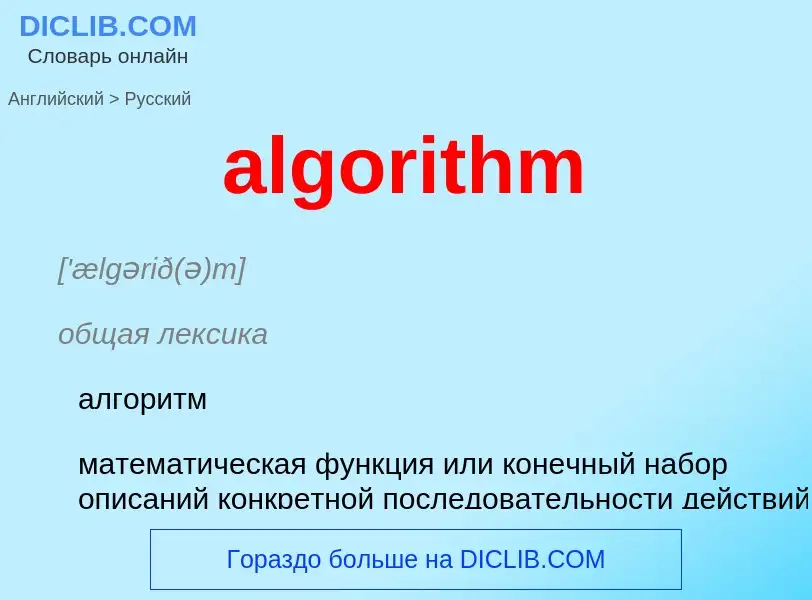Translation and analysis of words by ChatGPT artificial intelligence
On this page you can get a detailed analysis of a word or phrase, produced by the best artificial intelligence technology to date:
- how the word is used
- frequency of use
- it is used more often in oral or written speech
- word translation options
- usage examples (several phrases with translation)
- etymology
algorithm - translation to russian
['ælgərið(ə)m]
общая лексика
алгоритм
математическая функция или конечный набор описаний конкретной последовательности действий (правил), необходимых для того, чтобы компьютер или интеллектуальное устройство выполнили за конечное время некоторую задачу, сжатие изображения, выбор оптимального маршрута пересылки пакета или шифрование данных. Алгоритм может быть описан блок-схемой. Термин происходит от имени древнеперсидского математика Мухаммеда ибн Муса аль Харезми, написавшего трактат, посвященный алгоритмическому методу
метод, правило
синоним
существительное
специальный термин
алгоритм
- almost-dual algorithm
- approximation algorithm
- best-route algorithm
- composite simplex algorithm
- control algorithm
- decomposition algorithm
- dual algorithm
- dual simplex algorithm
- estimation algorithm
- maximin algorithm
- minimax algorithm
- network algorithm
- operative algorithm
- optimal path algorithm
- optimization algorithm
- prediction algorithm
- primal algorithm
- primal-dual algorithm
- search algorithm
- shortest route algorithm
- transportation algorithm
- verification algorithm
Definition
Wikipedia

In mathematics and computer science, an algorithm ( (listen)) is a finite sequence of rigorous instructions, typically used to solve a class of specific problems or to perform a computation. Algorithms are used as specifications for performing calculations and data processing. More advanced algorithms can use conditionals to divert the code execution through various routes (referred to as automated decision-making) and deduce valid inferences (referred to as automated reasoning), achieving automation eventually. Using human characteristics as descriptors of machines in metaphorical ways was already practiced by Alan Turing with terms such as "memory", "search" and "stimulus".
In contrast, a heuristic is an approach to problem solving that may not be fully specified or may not guarantee correct or optimal results, especially in problem domains where there is no well-defined correct or optimal result.
As an effective method, an algorithm can be expressed within a finite amount of space and time, and in a well-defined formal language for calculating a function. Starting from an initial state and initial input (perhaps empty), the instructions describe a computation that, when executed, proceeds through a finite number of well-defined successive states, eventually producing "output" and terminating at a final ending state. The transition from one state to the next is not necessarily deterministic; some algorithms, known as randomized algorithms, incorporate random input.


![Alan Turing's statue at [[Bletchley Park]] Alan Turing's statue at [[Bletchley Park]]](https://commons.wikimedia.org/wiki/Special:FilePath/Alan Turing.jpg?width=200)




